Irene Li
Large Language Models on Wikipedia-Style Survey Generation: an Evaluation in NLP Concepts
Sep 06, 2023Abstract:Large Language Models (LLMs) have achieved significant success across various natural language processing (NLP) tasks, encompassing question-answering, summarization, and machine translation, among others. While LLMs excel in general tasks, their efficacy in domain-specific applications remains under exploration. Additionally, LLM-generated text sometimes exhibits issues like hallucination and disinformation. In this study, we assess LLMs' capability of producing concise survey articles within the computer science-NLP domain, focusing on 20 chosen topics. Automated evaluations indicate that GPT-4 outperforms GPT-3.5 when benchmarked against the ground truth. Furthermore, four human evaluators provide insights from six perspectives across four model configurations. Through case studies, we demonstrate that while GPT often yields commendable results, there are instances of shortcomings, such as incomplete information and the exhibition of lapses in factual accuracy.
Going Beyond Local: Global Graph-Enhanced Personalized News Recommendations
Jul 31, 2023



Abstract:Precisely recommending candidate news articles to users has always been a core challenge for personalized news recommendation systems. Most recent works primarily focus on using advanced natural language processing techniques to extract semantic information from rich textual data, employing content-based methods derived from local historical news. However, this approach lacks a global perspective, failing to account for users' hidden motivations and behaviors beyond semantic information. To address this challenge, we propose a novel model called GLORY (Global-LOcal news Recommendation sYstem), which combines global representations learned from other users with local representations to enhance personalized recommendation systems. We accomplish this by constructing a Global-aware Historical News Encoder, which includes a global news graph and employs gated graph neural networks to enrich news representations, thereby fusing historical news representations by a historical news aggregator. Similarly, we extend this approach to a Global Candidate News Encoder, utilizing a global entity graph and a candidate news aggregator to enhance candidate news representation. Evaluation results on two public news datasets demonstrate that our method outperforms existing approaches. Furthermore, our model offers more diverse recommendations.
Topic-Centric Explanations for News Recommendation
Jun 13, 2023



Abstract:News recommender systems (NRS) have been widely applied for online news websites to help users find relevant articles based on their interests. Recent methods have demonstrated considerable success in terms of recommendation performance. However, the lack of explanation for these recommendations can lead to mistrust among users and lack of acceptance of recommendations. To address this issue, we propose a new explainable news model to construct a topic-aware explainable recommendation approach that can both accurately identify relevant articles and explain why they have been recommended, using information from associated topics. Additionally, our model incorporates two coherence metrics applied to assess topic quality, providing measure of the interpretability of these explanations. The results of our experiments on the MIND dataset indicate that the proposed explainable NRS outperforms several other baseline systems, while it is also capable of producing interpretable topics compared to those generated by a classical LDA topic model. Furthermore, we present a case study through a real-world example showcasing the usefulness of our NRS for generating explanations.
HiPool: Modeling Long Documents Using Graph Neural Networks
May 15, 2023Abstract:Encoding long sequences in Natural Language Processing (NLP) is a challenging problem. Though recent pretraining language models achieve satisfying performances in many NLP tasks, they are still restricted by a pre-defined maximum length, making them challenging to be extended to longer sequences. So some recent works utilize hierarchies to model long sequences. However, most of them apply sequential models for upper hierarchies, suffering from long dependency issues. In this paper, we alleviate these issues through a graph-based method. We first chunk the sequence with a fixed length to model the sentence-level information. We then leverage graphs to model intra- and cross-sentence correlations with a new attention mechanism. Additionally, due to limited standard benchmarks for long document classification (LDC), we propose a new challenging benchmark, totaling six datasets with up to 53k samples and 4034 average tokens' length. Evaluation shows our model surpasses competitive baselines by 2.6% in F1 score, and 4.8% on the longest sequence dataset. Our method is shown to outperform hierarchical sequential models with better performance and scalability, especially for longer sequences.
EHRKit: A Python Natural Language Processing Toolkit for Electronic Health Record Texts
Apr 13, 2022

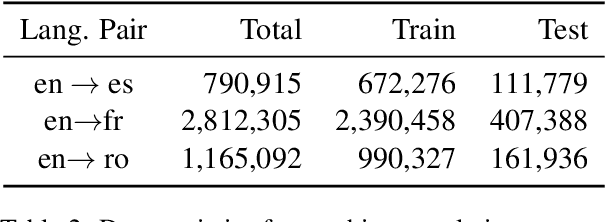
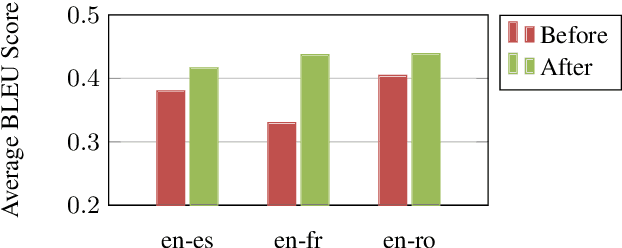
Abstract:The Electronic Health Record (EHR) is an essential part of the modern medical system and impacts healthcare delivery, operations, and research. Unstructured text is attracting much attention despite structured information in the EHRs and has become an exciting research field. The success of the recent neural Natural Language Processing (NLP) method has led to a new direction for processing unstructured clinical notes. In this work, we create a python library for clinical texts, EHRKit. This library contains two main parts: MIMIC-III-specific functions and tasks specific functions. The first part introduces a list of interfaces for accessing MIMIC-III NOTEEVENTS data, including basic search, information retrieval, and information extraction. The second part integrates many third-party libraries for up to 12 off-shelf NLP tasks such as named entity recognition, summarization, machine translation, etc.
A Transfer Learning Pipeline for Educational Resource Discovery with Application in Leading Paragraph Generation
Jan 07, 2022
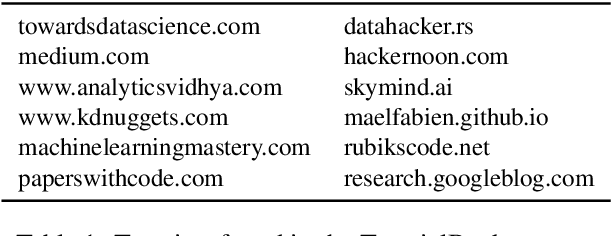
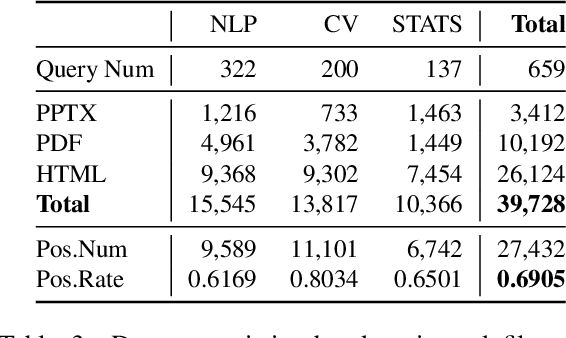
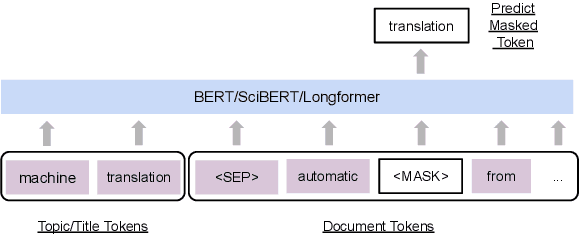
Abstract:Effective human learning depends on a wide selection of educational materials that align with the learner's current understanding of the topic. While the Internet has revolutionized human learning or education, a substantial resource accessibility barrier still exists. Namely, the excess of online information can make it challenging to navigate and discover high-quality learning materials. In this paper, we propose the educational resource discovery (ERD) pipeline that automates web resource discovery for novel domains. The pipeline consists of three main steps: data collection, feature extraction, and resource classification. We start with a known source domain and conduct resource discovery on two unseen target domains via transfer learning. We first collect frequent queries from a set of seed documents and search on the web to obtain candidate resources, such as lecture slides and introductory blog posts. Then we introduce a novel pretrained information retrieval deep neural network model, query-document masked language modeling (QD-MLM), to extract deep features of these candidate resources. We apply a tree-based classifier to decide whether the candidate is a positive learning resource. The pipeline achieves F1 scores of 0.94 and 0.82 when evaluated on two similar but novel target domains. Finally, we demonstrate how this pipeline can benefit an application: leading paragraph generation for surveys. This is the first study that considers various web resources for survey generation, to the best of our knowledge. We also release a corpus of 39,728 manually labeled web resources and 659 queries from NLP, Computer Vision (CV), and Statistics (STATS).
CLICKER: A Computational LInguistics Classification Scheme for Educational Resources
Dec 16, 2021
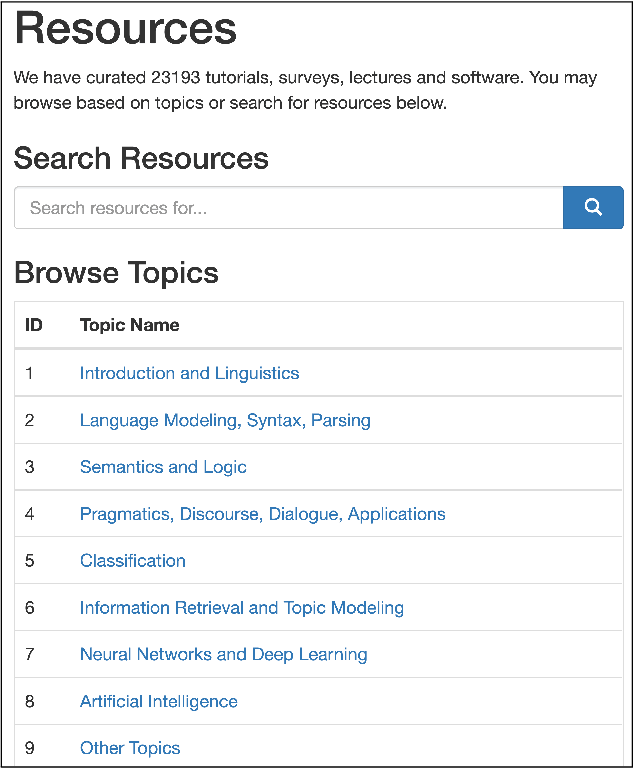
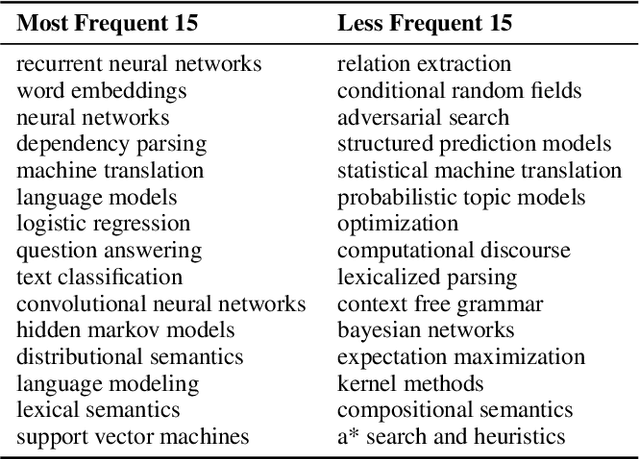
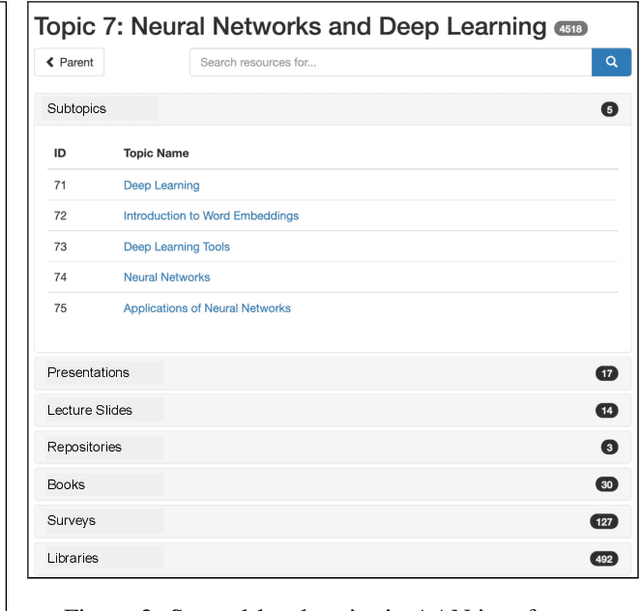
Abstract:A classification scheme of a scientific subject gives an overview of its body of knowledge. It can also be used to facilitate access to research articles and other materials related to the subject. For example, the ACM Computing Classification System (CCS) is used in the ACM Digital Library search interface and also for indexing computer science papers. We observed that a comprehensive classification system like CCS or Mathematics Subject Classification (MSC) does not exist for Computational Linguistics (CL) and Natural Language Processing (NLP). We propose a classification scheme -- CLICKER for CL/NLP based on the analysis of online lectures from 77 university courses on this subject. The currently proposed taxonomy includes 334 topics and focuses on educational aspects of CL/NLP; it is based primarily, but not exclusively, on lecture notes from NLP courses. We discuss how such a taxonomy can help in various real-world applications, including tutoring platforms, resource retrieval, resource recommendation, prerequisite chain learning, and survey generation.
Surfer100: Generating Surveys From Web Resources on Wikipedia-style
Dec 13, 2021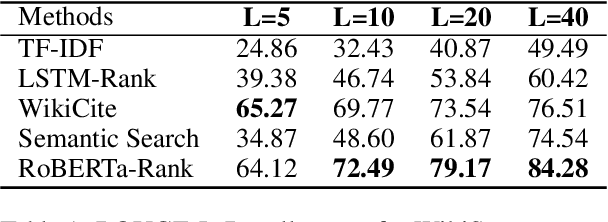

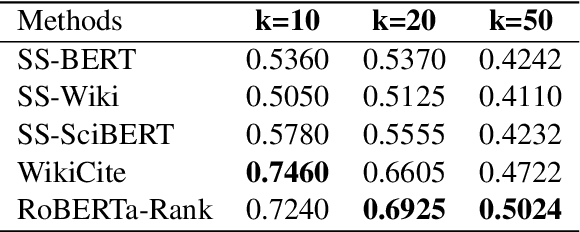
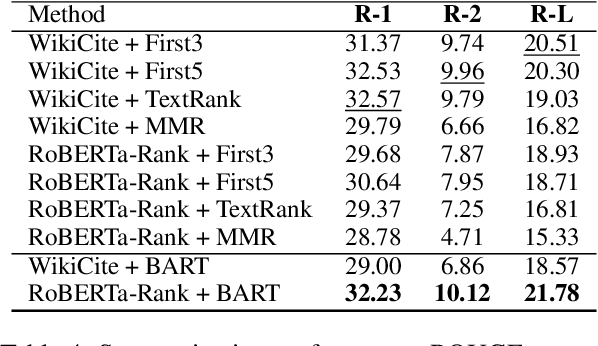
Abstract:Fast-developing fields such as Artificial Intelligence (AI) often outpace the efforts of encyclopedic sources such as Wikipedia, which either do not completely cover recently-introduced topics or lack such content entirely. As a result, methods for automatically producing content are valuable tools to address this information overload. We show that recent advances in pretrained language modeling can be combined for a two-stage extractive and abstractive approach for Wikipedia lead paragraph generation. We extend this approach to generate longer Wikipedia-style summaries with sections and examine how such methods struggle in this application through detailed studies with 100 reference human-collected surveys. This is the first study on utilizing web resources for long Wikipedia-style summaries to the best of our knowledge.
Efficient Variational Graph Autoencoders for Unsupervised Cross-domain Prerequisite Chains
Oct 06, 2021
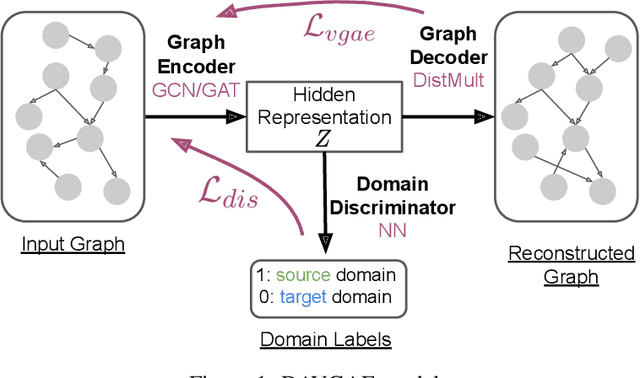
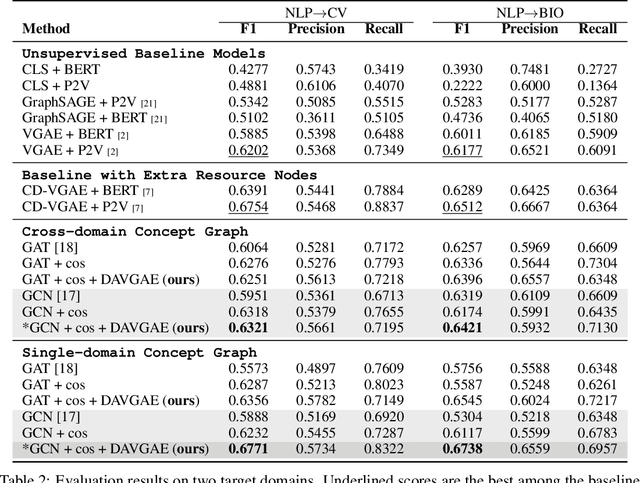

Abstract:Prerequisite chain learning helps people acquire new knowledge efficiently. While people may quickly determine learning paths over concepts in a domain, finding such paths in other domains can be challenging. We introduce Domain-Adversarial Variational Graph Autoencoders (DAVGAE) to solve this cross-domain prerequisite chain learning task efficiently. Our novel model consists of a variational graph autoencoder (VGAE) and a domain discriminator. The VGAE is trained to predict concept relations through link prediction, while the domain discriminator takes both source and target domain data as input and is trained to predict domain labels. Most importantly, this method only needs simple homogeneous graphs as input, compared with the current state-of-the-art model. We evaluate our model on the LectureBankCD dataset, and results show that our model outperforms recent graph-based benchmarks while using only 1/10 of graph scale and 1/3 computation time.
Neural Natural Language Processing for Unstructured Data in Electronic Health Records: a Review
Jul 07, 2021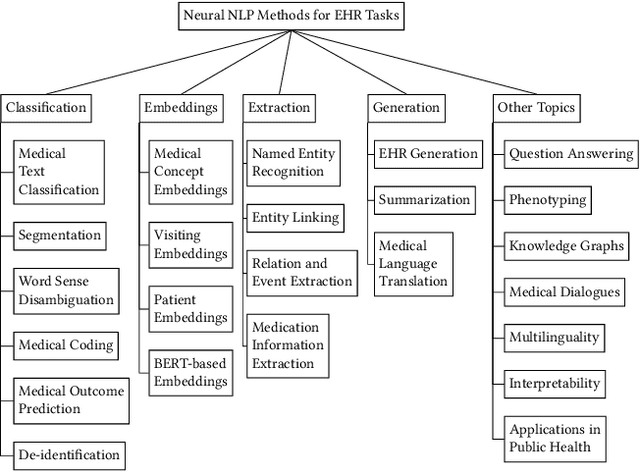
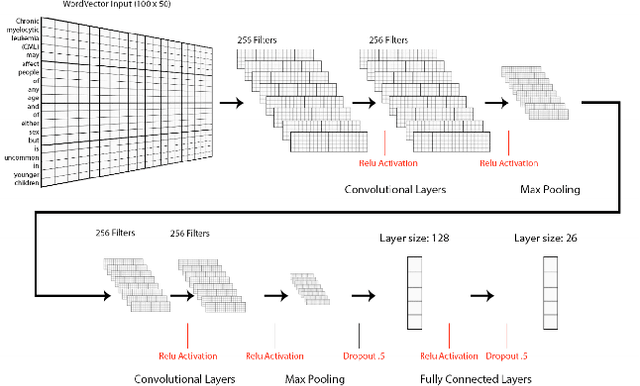
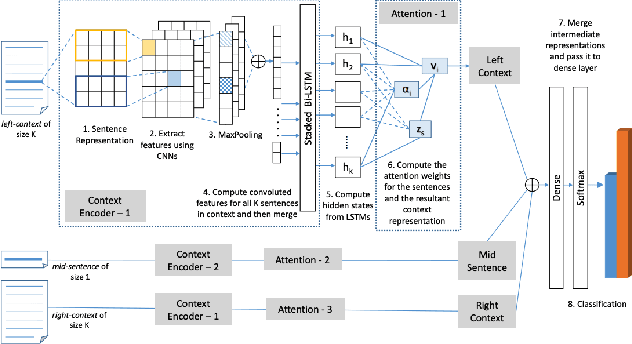

Abstract:Electronic health records (EHRs), digital collections of patient healthcare events and observations, are ubiquitous in medicine and critical to healthcare delivery, operations, and research. Despite this central role, EHRs are notoriously difficult to process automatically. Well over half of the information stored within EHRs is in the form of unstructured text (e.g. provider notes, operation reports) and remains largely untapped for secondary use. Recently, however, newer neural network and deep learning approaches to Natural Language Processing (NLP) have made considerable advances, outperforming traditional statistical and rule-based systems on a variety of tasks. In this survey paper, we summarize current neural NLP methods for EHR applications. We focus on a broad scope of tasks, namely, classification and prediction, word embeddings, extraction, generation, and other topics such as question answering, phenotyping, knowledge graphs, medical dialogue, multilinguality, interpretability, etc.
 Add to Chrome
Add to Chrome Add to Firefox
Add to Firefox Add to Edge
Add to Edge